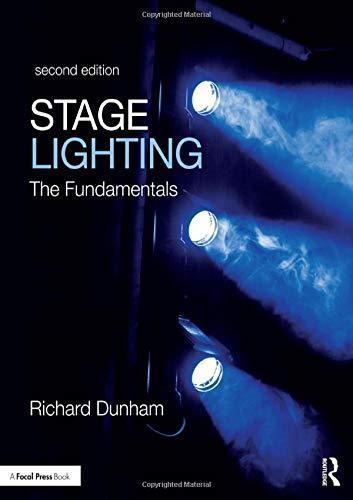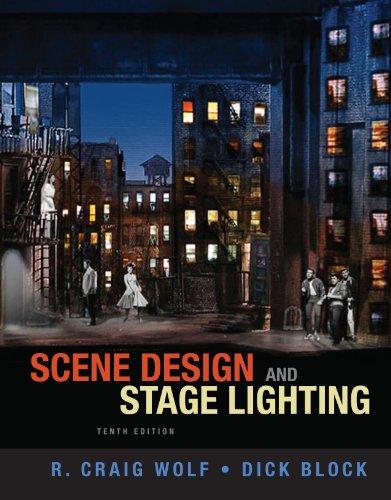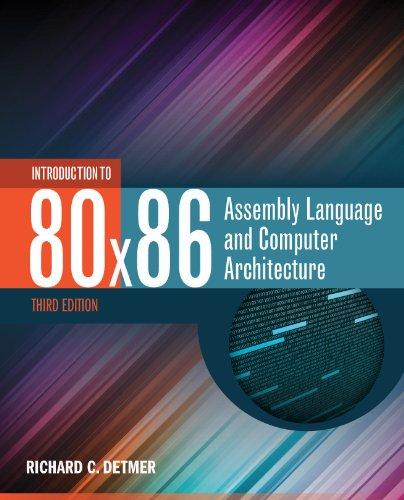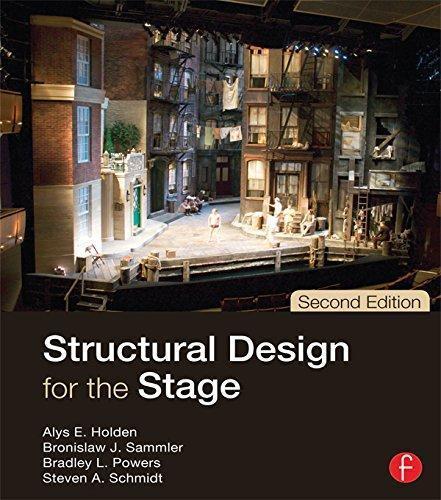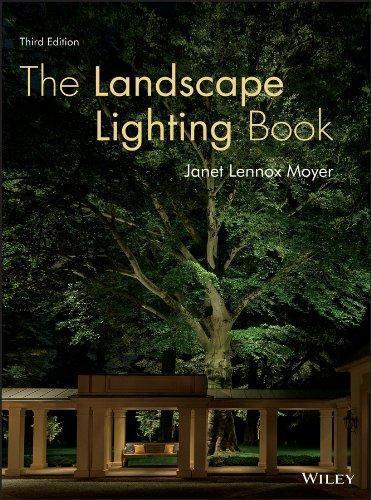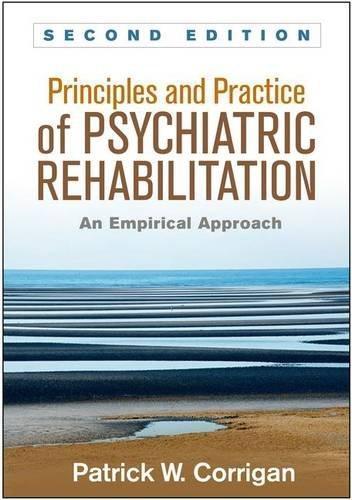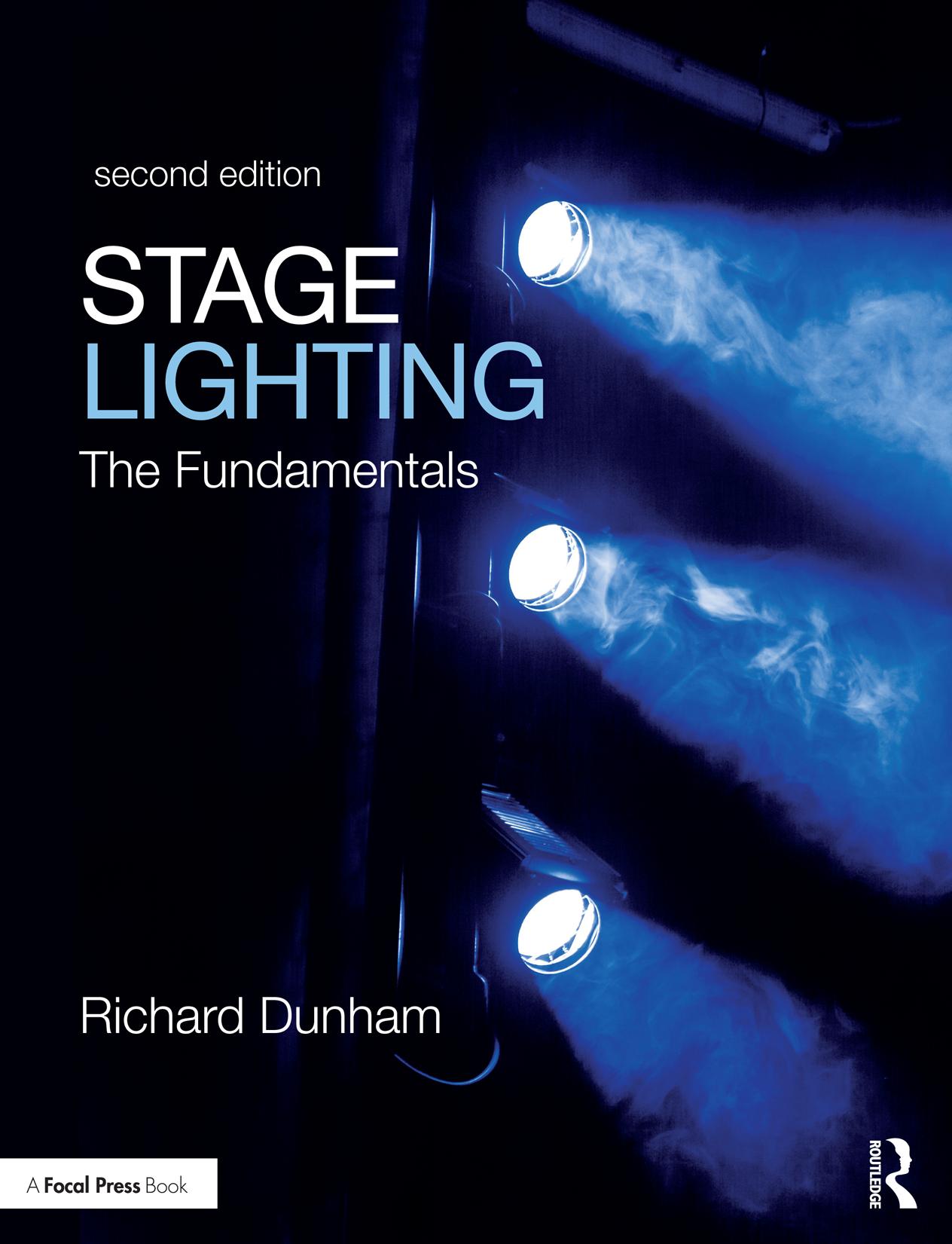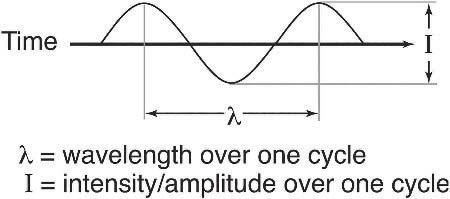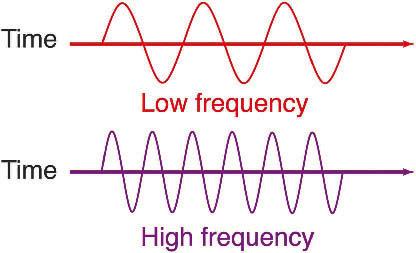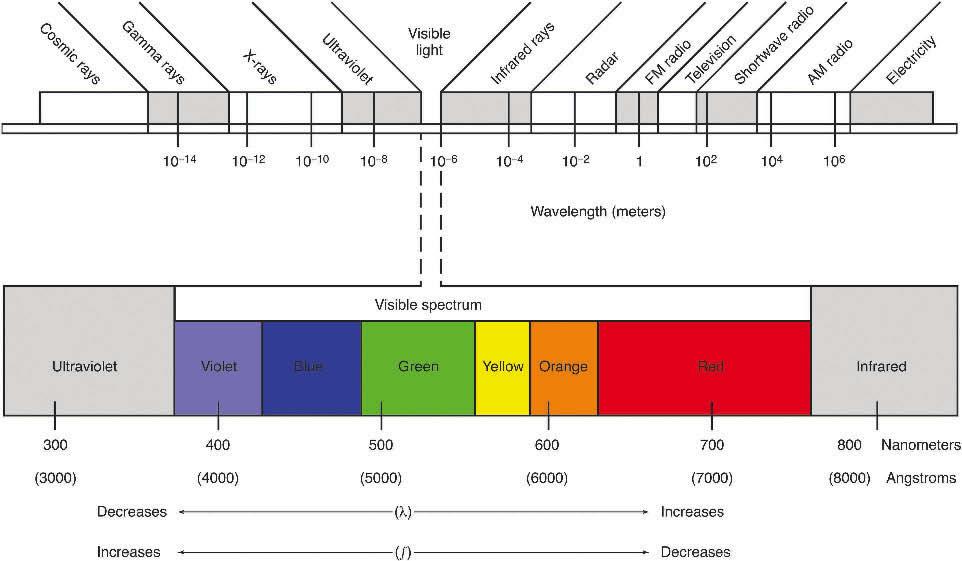THE NATURE OF LIGHT
BEFOREYOU CAN learn to design with light it is important to gain a basic understanding of the nature of light. Unlike other areas of design, light isn’t tangible: it appears to be mysterious and can cause unpredictable results, yet it has an impact on everything it touches. Light is controlled in ways that require at least some understanding of optics and electricity—topics that easily intimidate many people. As lighting designers, light itself is our medium, and we can usually convey our design ideas only through indirect methods such as with pencils, paints, or computer simulations. This is very different when compared to other artistic disciplines where the media are tangible. You can’t easily draw or render light as you would in a rendering of a scenic or costume design or with a sketch of a building, where a viewer can easily gain an understanding of a structure and color schemes that are created by a designer. The effects of light are in many ways a mystery until the lights are turned on and a subject is illuminated. Because of this, it is important to develop an understanding of the actual medium of light. What is it? How does it behave? How might we control it? What is its effect on other objects? With experience, you can predict many of the answers to these questions, but even then, you can’t be completely sure of your design choices until you see them actually revealed in light.
In this chapter I examine the physical properties of light, its makeup, and how it moves through space. I will also provide you with several methods that we use to describe light. Finally, I examine how light functions within our daily lives. These fundamental principles hold true not only in lighting dramas and other entertainment programs, but also for lighting buildings and natural settings where the sun and other light sources can be observed.
What is Light?
Quite simply, light is a form of energy. Specifically, it is a form of radiant energy that is associated with a given portion of the electromagnetic spectrum. Radiant energy is a form of energy given off by radiant bodies (heat/light sources) such as stars, like our sun. Radiant energy moves away from its source at a constant speed while light is but one form of radiant energy which has a speed of 186,000 miles/second. Most of us know this as the “speed of light.”
The Electromagnetic Spectrum
The electromagnetic spectrum represents all forms of radiant energy. Some researchers identify the electromagnetic spectrum with a particle-based theory while others refer to a wave-theory approach. Regardless of the theory, the general principles are the same. In each case, energy is thought to pulsate outward from a source at the speed of light in oscillations that create a wavelike effect and form patterns that can be measured. In fact, the variables that we generally use to describe radiant energy are based on wave theory. Most commonly we make distinctions between different forms of radiant energy through measurements of either frequency (f) or wavelength (λ). Wavelength is the distance between similar points in a waveform over the time that a wave completes one cycle, while frequency refers to the number of oscillations or cycles that a waveform completes over a given time. These variables
are inversely proportional to one another: as frequency increases, the wavelength gets shorter, or as frequency decreases, the wavelength gets longer. The strength or amplitude of the waves is commonly called the intensity (I). In visible light we often refer to this as the brightness of the light. Figure 1.1 illustrates the relationship between intensity, frequency, and wavelength.
In lighting, we generally use a measurement of wavelength to make a distinction between different types of light. The range of wavelengths produced by radiant sources is extreme. At one end of the electromagnetic spectrum we find electrical waves with wavelengths measured in miles. The 60-cycle electrical currents that are used in our homes may have a wavelength of more than 3,000 miles. Many other forms of electromagnetic radiation (ER) are associated with wavelengths so small that a special unit, the angstrom (Å), has been introduced to measure them. One angstrom is equal to 1/254,000,000 of an inch. At the opposite end of the electromagnetic spectrum from electricity are cosmic rays, which may have wavelengths as small as 1/10,000 Å. The electromagnetic spectrum is a collection of different types of radiant energy that can be specified through their varied wavelengths.
The Visible Spectrum
What concerns us as lighting designers is a very limited range of wavelengths contained within the electromagnetic
spectrum that we commonly refer to as the visible spectrum. This is a collection of wavelengths that can be sensed by the human eye. Those energy forms that lie outside of our perception with wavelengths that are longer than we can sense include infrared, radar, television and radio waves (with increasingly longer wavelengths). Energy forms with progressively shorter wavelengths that also lie outside the realm of our visibility include ultraviolet, x-ray, gamma and cosmic rays. Figure 1.2 illustrates the relationship between wavelength and the individual classifications of energy that make up the electromagnetic spectrum.
The visible spectrum can be further broken down into smaller components representing individual colors—each color representing a specific wavelength of radiant energy. We have all witnessed the rainbow effect produced through the refraction and separation of light into these individual colors by a prism, a storm cloud, or water spray from a hose or fountain. Every color represents light of a different wavelength or frequency. The range of wavelengths generally found within the visible spectrum extends from approximately 400 (violet) to 700 (red) nanometers. A nanometer is one-billionth of a meter. A second manner of expressing wavelength has already been introduced through the measurement known as an angstrom. An angstrom is 1/10 of a nanometer. In this case, the visible spectrum would be expressed as having wavelengths in the approximate range of 4,000–7,000 Å.
the eye and seeing
Our observation of the world around us is based solely on the manner in which we sense our environment. We can’t directly observe anything without the aid of various senses. If you think back to a basic biology class you will probably remember that the human body is equipped with five sensory devices. The senses that these manage include sound, touch, smell, taste, and sight. Each sense consists of a series of sensory organs that convert physical phenomena into nervous impulses that our brains process in a way that helps us to observe the world around us. Our skin allows us to feel, our ears allow us to hear, and our eyes allow us to see.
The visible spectrum represents the range of wavelengths to which the human eye can sense light. If we were sensitive to light relating to a different range of wavelengths, our visible spectrum would shift to a different portion of the electromagnetic spectrum. An infrared camera, such as the ones used in defense or security systems, is sensitive to a different portion of the electromagnetic spectrum than the human eye. Hence, in a situation such as a dark night where we cannot see the movements of people like prowlers or soldiers, the camera is able to “see” for us.
Figure 1.1a Wave relationships. a. Relationship of intensity (I), wavelength (λ), and cycle or frequency (f)
Figure 1.1b Frequency (f) and wavelength (λ) are inversely proportional
the ControLLabLe QuaLities of Light
It is important at this point to introduce a vocabulary that enables us to define and describe light. One of the most difficult tasks for a lighting designer is in describing the lighting envisioned for a project. Light is our medium and it cannot be illustrated effectively through an indirect means such as with a model or rendering. A scenic designer can illustrate to a reasonable degree of success a final design and color palette for a project through the use of markers, pencils, or paints. Likewise, in addition to renderings, a costumer can present swatches or scraps of fabric to indicate the materials from which a costume will be created. This isn’t so with a lighting design, where light itself is the medium and where nobody can get a true sense of the outcome of a design until the actual lights (luminaires) are placed in the performance space, colored, and balanced through setting specific brightness levels for each light. Because of this, several descriptive qualities have been defined to help us communicate with one another about light. These are generally not thought of in terms of quantitative elements but are used instead to help us set up a comparison between various lights and lighting effects. While absolutes may come into the discussion, most of these qualities are used solely within a descriptive or comparative basis. These qualities are also universal and can be translated to any field of lighting, whether working in traditional theatre or lighting an office tower,
garden, or the latest Rolling Stones tour. While there may be slight variations in terminology between lighting disciplines, most designers have come to refer to four primary qualities for describing light. Any light, no matter how produced or modified can be described through these four attributes. The variation of any one of these qualities will make a distinction between any given example of light. These qualities include intensity, distribution, color, and movement. As a whole, these are essentially the same qualities that Stanley McCandless described in 1932 when he first wrote A Method of Lighting the Stage
Intensity
The most easily described quality of light is intensity, which refers to the brightness of the light. While it might be described very specifically and can be evaluated through measurements such as the candela or footcandle, it is more often described through a comparative basis. “This light is brighter than that light,” “this light is approximately half the intensity of another light,” or “that light is as bright as the moon” are examples of this type of comparison. The human eye can perceive light at an extreme range of intensities. In World War II, soldiers learned that a German scout plane nicknamed “Bed Check Charlie” could see the tip of a lit cigarette from several miles away. If they were spotted, soldiers could anticipate a visit from a bomber sometime later
Figure 1.2 The electromagnetic and visible spectrums
that night. At the other extreme, the intensity of a light can be so bright that it becomes harmful and could even cause damage to our eyes. Examples of this would include looking directly into the sun or being exposed to the bright light that accompanies welders as they strike an arc. In most theatrical venues we are generally concerned only with the relative appearance of the light and whether there is enough visibility to see what has to be seen at any given moment on the stage. In video and film lighting, the intensity isn’t as flexible, and there is a minimum threshold of intensity that a director of photography must provide to maintain a proper exposure for a setting. We have all taken photographs of last Friday night’s party or some other special event to find that the results that our phone or camera captured produced only shadowy silhouettes that we think we recognize as our friends. Even with today’s mobile phone cameras we often find that images can suffer from poor lighting and are either under or overexposed. Architectural lighting designers speak of a minimum amount of illumination for a given visual task or job. These tasks require a minimum number of footcandles or lumens of illumination. For example, the lighting levels required for a personal home are much lower than those needed at a retirement home, where elderly residents often have trouble seeing, while a meeting room requires higher intensity levels than a restaurant seating area—although none of these settings would require the illumination levels needed for an assembly line producing high-tech products. Regardless of whether describing a specific level of illumination (i.e., footcandles) or simply describing intensity on a comparative basis, intensity becomes one of the most important ways of helping us distinguish between different types of light and lighting.
Another important element of intensity relates to the principle whereby the intensity of a light drops off dramatically as the distance from the source is increased. This is expressed through a concept/formula known as the Inverse Square Law. This law will be presented in more detail in Chapter 7, but simply states that the illuminance of a light source is inversely proportional to the square of the distance from the source. A quick examination of this principle can be demonstrated by playing a flashlight on a wall and noting the apparent brightness and coverage of the light while varying the distance that the flashlight is held from the wall.
Distribution
The second controllable quality of light is known as distribution. McCandless described this as “form.” Most lighting designers relate distribution to two specific properties of light: angle (or direction) and quality. Angle refers to the direction from which the light is coming. Where are you hanging the light source? How does it play upon the subject? Where are the highlights?
Where do the shadows fall? A light coming from behind the subject presents a completely different image and associated mood than a light coming from in front of the subject. A couple walking hand-in-hand into a sunset presents a much more dramatic image than if the sun were directly overhead. Dracula would most likely not appear so scary if we chose to light him in any other way than through a silhouette. The angle of the light helps to define or reveal the form of an object. Light directly from the front tends to flatten a subject and will cause the subject to appear two-dimensional, while from the side it tends to sculpt and etch the subject away from its background. Backlight tends to push objects forward, while downlight tends to squash the subject. A light from below generally appears unnatural and can be used to create effects that clue audiences into peculiarities within a production. Architects can use these principles to make a room appear larger or smaller.
Quality refers to the texture and characteristic features of the light. Some lighting may be harsh and crisp—representing strong parallel rays—while other lighting will reflect a soft diffuse quality. Are the edges of the light and shadows sharp and well-defined or are they soft and fuzzy? Compare a clear sunny day in summer with the cold gray light associated with a December afternoon. Is the light even in distribution, or are there patterns? A typical contemporary classroom lighting scheme will most likely result in a soft, even wash of light over the entire room with some form of fluorescent fixtures. In comparison, a warehouse set in 1930 would probably be lit with single-bulb fixtures with simple shades that would produce cones of light throughout the structure. A walk on a sunny day through an open field exposes you to a very different kind of light than the textured light that you would expect once you move into a wooded area, where the trees create patches of light and shadow along your path. Lighting designers can create their own textured light by inserting patterns known as gobos into the fixtures that illuminate a space. While gobos were first utilized in entertainment designs, they have now become elements of architectural and display lighting as well.
Color
The third controllable quality of light is color, which is considered by many to be the most dynamic of the controllable qualities of light. Light will have an associated color that is determined through the specific collection of wavelengths present within its makeup. Hence, you might have a lavender light, a red light, or a blue light— each one distinguished from the others by those wavelengths of light found within its composition. However, color is actually a perception based on how specific wavelengths of the light stimulate the photo sensors in our eyes. Light, more importantly, has a major impact on
the color of any objects that it falls on, and the resultant color is a factor of both the object’s surface color and that of the light that strikes the object. All objects selectively absorb or reflect various wavelengths of light—which becomes the means by which we determine the color of any object. The use of a light containing some or all of the wavelengths of light that are naturally reflected by an object will generally result in enhancing that object’s color. On the other hand, the use of a colored light with limited or no common wavelengths with that of an object will result in a distortion and graying of that object’s color. Color is produced through the spectral makeup of the light source itself, through the removal of specific wavelengths of the light through filtering, or by the selective absorption of a light’s wavelengths by a surface. While it is generally agreed that color is the easiest quality of light to observe, it is also commonly acknowledged that due to the unpredictability of its results, it is perhaps the hardest quality to master and control.
Movement
The final quality of light is movement, which refers to changes in the light from moment to moment. This might be represented in a number of different ways: First, the actual movement of the light source. This is quite common and can be illustrated by a candle or flashlight carried across a room, where you actually see the source move from one location to another. A second form of movement involves observing the movement of the light without actually observing the light source directly. Two examples of this include watching the effect of a followspot on a rock musician and the use of a progression of lamps to light actors as they move from one stage position to another. In the first example, you see the effect of the light following the musician, but you can’t see the actual spotlight because it is located somewhere behind you at the rear of the auditorium or arena. In the second example, lights slowly come up along the path that the actors walk such that
the individual lights precede the arrival of the actors to specific locations on the stage. For even more effect, the individual lights could also slowly dim down once the actors move beyond their positions to other locations along the path. The last element of movement relates simply to changes within the lighting over time. This is the one that theatrical lighting designers deal with most often as they create cues for a production. For all practical purposes this would come about through making changes in any of the other three controllable qualities of light. Lights suddenly getting brighter or dimmer, shifting to another color, or slowly moving to a different angle all form examples of this kind of movement. The movement may be nearly instantaneous (i.e., flipping a light switch on or off) or could involve long transitions like sunset sequences that are so subtle that a viewer isn’t aware of the lighting changes being made from one moment to another. Movement can also be thought of as a transition in lighting. While there are occasions where the lighting for an environment may be static, most of us consider transitions in lighting to be just as important as the images that a designer creates for a given project. In summary, all lighting conditions reflect the manipulation of these four qualities. Whether you light a building, a museum display, an opera, or any other form of entertainment, each moment that a viewer observes can be associated with a given combination of intensity, color, and distribution in the lighting. Movement can most often be directly related to the transitions between different “moments” (also called “looks,” “states,” or “cues”). Each of these terms refers to names that a designer may use to refer to a static view of the lighting. Movement provides the fluid, dynamic quality required in a lighting design—a quality that many of us believe is just as important as the combination of fixtures, colors, and intensities that one sees at any given time. If mounted correctly, the lighting can greatly enhance a production or project. If done incorrectly, it can quickly become an interruption or distraction for the viewers.
Sidebar 1.1 DESIGNER PROFILE
A creative force in the New York theatre since the mid-1970s, Ken Billington is one of Broadway’s most successful lighting designers. He remembers his first attraction to stage lighting from when he was in the fourth grade. From that point on, all Ken “wanted to do was lighting,” but it wasn’t until he was in junior high school that he realized that there were actual “lighting designers” in the world and that it was a proper design discipline. Finishing high school,
he went directly to Manhattan to study at The Lester Polakov Studio and Forum of Stage Design, apprenticing with both Peggy Clark and Tharon Musser. In fact, he often claims that he went to “Musser U” and credits that legendary designer with his first big break.
Ken has designed a hundred Broadway shows, 70 off-Broadway shows, and operas for companies worldwide, as well as for concerts, theme park

shows, and architecture. He is often associated with lighting large musicals and spectaculars, with design credits that include the original Sweeney Todd, White Christmas, Footloose, and Chicago (the longest-running American musical in history). For 27 seasons, he designed the Christmas and Easter shows at the Radio City Music Hall and has lit a range of celebrated personalities, including Ann-Margret, Shirley MacLaine, Carol Channing, Liberace, and Hugh Jackman. Ken’s designs have enhanced such extraordinary projects as Fantasmic at Disneyland, the lavish aquatic show at Seaworld Parks (Orlando, Florida; San Diego, California; and San Antonio, Texas), productions at Busch Gardens (Williamsburg, Virginia), and spectacular ice shows, including Stars on Ice. His television work includes many PBS theatre, concert specials, and several episodes of the NBC series Smash. His architectural designs have highlighted such New York landmarks as Feinstein’s 54 Below and Tavern on the Green. Ken has been honored with most of the awards presented for lighting design in the theatre, including a Tony Award for Chicago and the Distinguished Lighting Designer Award from the United States Institute for Theatre Technology (USITT). In 2016, Ken became only the third lighting designer to be inducted into the Theatre Hall of Fame.
Ken considers himself primarily a “Broadway” designer, but his career embraces many creations beyond the New York stage. “I have done as many as five Broadway shows in a year,” he says, “and only one the following year, but that year might include six shows that tryout and hope to come to New York. As a freelance designer, you have no idea where the jobs will come from each year.” He expanded his career beyond the theatre, he declares,
“ by using “common sense” to apply what I know about stage lighting in other areas of lighting design. The basics of lighting—angle, color, intensity, and concept—remain the same in all venues. The manner of execution may differ, and you may need a different technical language as you move from collaboration with a stage electrician to working with a contractor, but the final product is the same: designed lighting.”
Ken’s experience has underscored his belief that lighting is a collaborative process, and the challenges, rewards, and personal friendships that come with being part of a creative team are what keep him excited about his art: “I can’t paint or draw a picture, but I can paint with light. It is the same for any artist. Why do you do this? And, of course, it’s always thrilling to sit in a theatre and see what you have created on paper come to life.”
In order to remain current in his always-evolving craft, he reads the trade magazines, attends conventions, and makes himself available to sales people who come to his studio, talking directly to company reps about innovations in technology. He maintains, however, that the best way to remain up-to-date is simply going out and admiring what his colleagues are doing and observing the current trends for himself. He remains an enthusiastic theatregoer. When asked what he considers Rule Number One in lighting design, Ken is firm: “Concept! No matter what the project, big or small—if there is no concept, you will usually get yourself and the production into trouble.” Ken also believes in hands-on training:
“ The best way to learn how to light is by lighting, no matter what the project. You might do a great job or just an okay job, but remember that even if you really screw up, the worst that will happen is that you’ll get fired—they don’t take you out back and shoot you. No matter what the project, learn from it—look at what worked and what did not work and file it away and remember it for the future.”
Credit: photo courtesy Ken Billington
Ken Billington
funCtions of Lighting
There are numerous functions associated with lighting. Light is used to reveal. Many of the functions of lighting relate specifically to the manner in which light is used to reveal an object(s) or setting. While most lighting designers agree in principle with many of the named lighting functions discussed in the following sections, sometimes designers may combine several of these functions into larger groups or associate a different term with a given function. In these cases, what is important is the performance of the function rather than the specific name used by a given individual. In reality, lighting designers combine and modify the controllable qualities of light to produce the varied functions that we find within any specific lighting. I will discuss the functions of lighting from a more traditional theatrical or entertainment background first and then go on to relate several other functions of lighting that are more specific to other practices. Again, it is important to be aware that many of the functions are characteristic of all types of lighting design.
Visibility
Most lighting designers would argue that the most important element of lighting is visibility. Many even refer to it as the primary function of lighting. After all, isn’t this why we created artificial light in the first place? Visibility simply refers to the principle of using light to reveal or illuminate objects. In the early days of lighting, the job of the designer was nothing more than to create enough light so that the audience or occupants of a space could see. In many ways this philosophy of lighting was based on the premise that more was better and that the more footcandles or lumens of light placed on a stage or in a room, the better visibility that you had. Since the 1950s or ‘60s, theatrical designing moved towards a concept that we call selective visibility, which simply refers to revealing to an audience only what needs to be seen. Hence, a less-revealing image on stage might be more appropriate for the dramatic action than a fully illuminated stage. In selective visibility, areas of low intensity, shadows, silhouettes, and high contrast can become effective elements in a lighting designer’s arsenal of tools. An image of Dracula appearing from the shadows is much more terrifying than seeing him come to his next victim in full light. Until recently, architectural lighting has been known for being largely dependent on the quantity rather than the quality of its lighting, and most recommended practices of the past carefully specified the minimum number of footcandles that were required for a given task or environment. Finally, while it may appear obvious that the level of illumination plays a dominant role in the visibility of an object, it is not the only control that has an effect
on whether you see something or not. The angle of the light also determines how much or little of an object is revealed to you. The color of the light might help an object either blend in or pop out from its background and will also enhance or gray the object’s color. These are just a few of the additional elements that can have an effect on visibility.
Mood
Another function of lighting relates to creating mood. Mood refers to the observer’s emotional response to the lighting. Lighting can be foreboding or inviting, carefree and light, energetic versus passive, or tragic and oppressive. In all of these and many more moods, the light provides an atmosphere or ambiance for the environment that is being lit. Other than visibility, mood is probably the function of lighting that has the next most important impression or effect on a viewer. Studies have shown that light can have a profound effect on individuals and their moods. In entertainment lighting, we often produce extreme ranges of mood for a given theatrical production or special event. These moods may also be changed many times throughout a twoor three-hour performance. Mood changes may occur quickly or may be so subtle that the audience isn’t necessarily aware that the changes have even taken place. A well-lit production will have lighting that reflects the varied moods of a piece while also following the rhythm of the changes that occur throughout the script. In architectural lighting, more subtle choices are used to produce environments for more productive offices, more welcoming reception areas, and to provide calming effects for patients in medical facilities. Lighting has also been used to influence sales volumes and turnover rates in retail markets. As an example, consider the lighting associated with a fine restaurant like a favorite bistro versus any number of fast-food restaurants. The soft, amber lighting associated with a bistro is very different from the harsh, bright, fluorescent lighting that is characteristic of most fast-food restaurants, where turnover is key to a successful business. In this case, the lighting helps create an environment that prevents patrons from becoming too comfortable in fast-food establishments.
Establishing a Scene
Some functions of lighting are related specifically to the discipline that you are designing within, while others are consistent with almost any kind of lighting. For instance, in a theatrical production it would be critical for the lighting to help establish or communicate specific information about the play or environment that is being created. Time of day, season, and geographical location are all parts of this function. Many refer to this
as establishing a scene. In short, the lighting, as well as all the other elements of the scene, must combine to create a single cohesive environment that creates a “true” world of the play. A play that requires a night scene must be lit in some fashion that would be suggestive of night. This could be a night with lights on or lights off, lights that would suggest a specific interior lighting (i.e., a chandelier versus a fireplace or table lamp), or even lights that are suggestive of a specific type of light source or historical period (electric versus gas or candlelight). All of these form specific design considerations that lighting designers should consider as they light the given night scene. Establishing a scene is much more important for an entertainment lighting designer, who is concerned with creating a world for a performance, than an architectural lighting designer who is simply lighting a particular space. In reality, though, even the architectural designer must create a design that deals in some manner with establishing a scene that is consistent with producing the proper response or ambience for a building or environment. An example would be in creating the appropriate lighting for a five-star restaurant versus an office suite. There is an appropriate and unique approach to lighting each of these projects.
Modeling
Another common function of lighting is in modeling or sculpting. Some designers refer to this as “revelation of form.” This function relates to using light for enhancing the three-dimensional qualities of an object. We can best distinguish form through carefully observing the highlights and shadows of an object. Highlights represent the flashes of reflected light from areas that are directly illuminated by a light source, while shadows may be represented by either the area of an object that is not lit or the area of darkness or shadow that is cast by a lit object (cast shadow). Areas that are raised are prone to highlights, while recessed surfaces usually fall into shadow areas. However, this revelation of highlight and shadow is dependent on both the angle and number of lights that strike an object. As an object is lit from different directions more, or less, of its surface textures and associated form are revealed to the observer. As a rule, the best light for revealing an object’s form or three-dimensional qualities is to its side. Angles that come from either behind or in front of an object tend to create more of a two-dimensional or profile-like image of the subject. The vertical angle of the light source(s) also has an effect on how the object is revealed to an observer. As an experiment, try shining a light on a piece of molding (like a cornice) from different angles. The light can change your perception of which parts of the molding are inset or raised. In fact, when lit from straight front, the individual shapes might even be masked and may not reveal any depth at all.
Focus
Focus is a lighting function that relates to drawing attention to various elements within an environment. Architectural designers often refer to this as accent lighting. It is actually common to have several different layers of attention or focus established for a stage or given space. The single most important focus is generally referred to as the primary focus of a scene or environment. While a given subject may be less prominent than the primary focus, it may well appear more prominent than the rest of the environment, which results in creating a secondary focus for a scene. One role of a lighting designer is to help point out where a viewer or audience member’s attention should be directed at any given time. In a typical theatrical application the audience members’ view is confined to the stage, while in a building, occupants have the potential to look wherever they wish. The signage at an airport should be lit in a manner that allows passengers to easily navigate between locations such as gates, ticket counters, and baggage claim areas. On a stage, what should the audience be watching at any given moment? Who in the band has the solo? How do you bring attention to a specific scenic element of a setting? Techniques that a lighting designer can use to control focus include many familiar tricks. One example is simply blacking out an entire stage except for those areas where the focus must be directed. Highlighting an actor delivering a monolog within a single spotlight or pulling lights down to a single light on a significant prop like an empty wheelchair form examples of this type of directed focus. In a more subtle manner a designer may simply boost or raise the intensity of the light around an area to which they want to direct your focus. Brightening the lights around furniture clusters such as tables or seating areas is a common practice for lighting relatively long conversations that take place in specific locations. Another example of this is when an entrance is pointed up by boosting the level of a special that is focused on the door from which an actor will enter. It is important to understand that we use relative brightness to help direct focus. While I have spoken of raising the intensity of light on a subject, an equally valid and at times even preferred technique involves lowering the intensity of the areas surrounding the point to which we want to draw focus.
An architectural lighting designer uses the same concepts to draw an occupant’s attention to various details in a room or building. Directing track lighting onto wall hangings or photographs, placing more light around a hotel lobby’s reservations desk, or creating focusable lighting for product displays in a department store all form examples of using light to direct focus. The eye will usually focus on the element within our vision that is different from other objects in view. Lighting designers can also use color to establish focus.
Placing a single white light on the lead singer while the rest of a band is bathed in magenta-colored light is an example of this. A designer does not necessarily have to make use of extreme color differences to make use of this principle. A night scene in which the entire stage is cast in blue light, with bluish lavender moonlight streaming through the French doors where Dracula is to appear, can be just as effective of a use of contrast in color.
Composition
Composition is a function of lighting that relates to combining all of the elements of a stage or room together into a complete visual package. We see nothing until it is revealed to us through light, and one of the lighting designer’s primary responsibilities lies not only in choosing what to reveal to us but also how it is revealed to us. While other collaborators give us the primary elements of a composition, such as the scenery and costumes, the actors or characters, and the furniture, the lighting designer can reveal these objects in an infinite number of ways. By comparison, the lighting designer often makes the largest single contribution in determining the overall composition of a stage or environment. The same objects or space can appear quite differently with just a couple of simple alterations to the lighting of the environment. The lighting also determines how all of the individual objects and designs tie together as a whole; it becomes a unifying element for most design projects.
Style
Style represents yet another function of lighting. It relates to creating visual traits that allow a characteristic overall visual quality to be connected to a given production. In reality, style is specifically determined through the collaboration and discussions of the entire production team. While we may discuss the style of any given production, we may also use style to compare and contrast a project with other productions or projects. An architect may refer to postmodernism, while a director might speak about absurdism. In each case, style is representative of various visual qualities that are characteristic of each school or movement. The scenic designer, director, costume designer, and lighting designer must share a common understanding of the style of a production in order to realize a successful unified project. Most importantly, once the style is agreed upon, a production should remain consistent in the manner in which it approaches style. A number of designers will discuss theme as an element of style. How is the play constructed? Does the playwright use a specific type of delivery? Are there social and visual themes within a production? A lighting design must help reinforce the visual quality associated with the remaining elements
of a project. One manner in which style becomes most readily identified is through establishing the degree of realism in a production. How literal is the world that we are creating? Could this be a naturalistic environment? Are there any symbolic elements? Are there any recurring themes to be reinforced or emphasized? Are we simplifying our image so that it contains only those elements that are absolutely essential to the action? Are period realism and historical accuracy important to the piece? Should there be a limited color palette? How are the traditional elements of design (line, form, texture, etc.) characterized within a given project? Are particular conventions used in the production? All of these questions form examples of issues that will help a design team define a project’s style.
Staging the Story
In the case of entertainment design we also need to consider the actual techniques of production as another function of lighting. A number of designers refer to this as staging the story. In principle, this simply means taking the script and finding a proper mechanism for presenting it to an audience. In a production making use of a single box setting, a design team may simply use the act curtain and a series of blackouts to make distinctions between various scenes. Lighting transitions have become one of the most important means of enabling us to quickly shift the reality of a play from one location to another. A very different approach would be required for a production containing 20 independent scenes in which each scene requires a different location. Do we need to observe the entire space, or can we break it up through using smaller locations such as platforms? Is a unit set part of the design solution? Can tightly confined specials be used to define the spaces required by the action of the play? What scenic mechanisms might we utilize to move from one scene to another? What theatrical conventions will be used throughout the production? Are there specific lighting techniques or equipment available that will help us present the play to an audience? How are transitions handled? The answers to these and other similar questions will help establish the style of both the production and its lighting.
Rhythm
A final function of light that relates primarily to entertainment lighting is rhythm. Rhythm in lighting relates essentially to movement and transitions; it may be very subtle and unobserved or dramatic and very apparent to the audience. Rhythm can relate to transitions based simply on the logistical needs of making the production workable for an audience (staging the story), or more importantly, rhythm can follow the dramatic tensions of a production. Do changes from one scene to another
occur in a natural, fluid manner, or are they disruptive to the flow of the show? We’ve all witnessed those times where the lighting isn’t quite in sync with the actors, scene changes, or other elements of a production. A second form of rhythm relates to the changes that occur as a result of various movement patterns (blocking) with the actors, changes in mood, focus, or any other requirements that make a dramatic comment on the play through the lighting. As tensions mount and are resolved, the lighting should underscore the associated emotional changes throughout a production. Often, the lighting will build as a scene moves towards its climax. A well-designed production will be dynamic and will have lighting that follows the rhythm of the rest of the show. In fact, it has been demonstrated that lighting that remains too static may have a negative impact on audience members. Even contemporary architectural lighting applications now make allowances for rhythm when lighting many projects. Not only is rhythm varied throughout the day in offices and other workplaces, but it also can become a major design element for large exterior objects such as building facades and towers, landscape architecture, and even bridges. In these cases, the
lighting of a structure may change color through intervals of as little as 30 seconds to as long as 30 minutes or longer. Rhythm can also be observed in something as simple as the spacing intervals and patterns that are created when laying out a group of luminaires, such as an arrangement of ceiling fixtures.
for further reading
DiLaura, David L., Kevin W. Houser, Richard G. Mistrick, and Gary R. Steffy. eds. Illuminating Engineering Society–The Lighting Handbook Tenth Edition: Reference and Application. New York: Illuminating Engineering Society, 2011. Illuminating Engineering Society of North America. IESNA Lighting Education 150 (Intermediate Level). New York: Illuminating Engineering Society of North America, 1993. Illuminating Engineering Society of North America. IESNA Lighting Ready Reference. 4th ed. New York: Illuminating Engineering Society of North America, 2003.
McCandless, Stanley. A Method for Lighting the Stage. 4th ed. New York: Theatre Arts Books, 1958.
McCandless, Stanley. A Syllabus of Stage Lighting. 5th ed. New Haven, CT: Yale University, 1941.
Rae, Mark. ed. IESNA Lighting Handbook. 9th ed. New York: Illuminating Engineering Society of North America, 2000.
LIGHT AND PERCEPTION
THEIMPORTANCE OF light in the perception of our world cannot be overstated. Light, by its very nature, allows us to see and therefore perceive the environment around us. Because we observe the world through images that are created through the stimulation of our optic nerves and nerve impulses, we have to account for the fact that what we sense is actually an indirect means of observation. Therefore, images can be interpreted very differently from one person to another. This, to some degree, is due to our personal backgrounds, which add interpretive elements to these observations that are based on our past experiences. In addition, we may simply experience different degrees of stimulation from one individual to another. For instance, we learn to define the color that we call “red” based on our experiences of what our parents taught us was the color red. After a time, we learned to associate the color red with a given experience of sight. However, if we are given a more complex color, such as an orange-red or an orange-orange-red, we may have trouble distinguishing the point at which the orange-red shifts into becoming an orange-orange-red as we add more yellow to the color. In this case, we define the new color based on our personal experience, and one person’s experience may be quite different from that of another’s. The color hasn’t changed—only our perception of that color. Another manner in which we might perceive different experiences in light comes from sensing the light in different ways from others. For example, some people are color-blind. Their experience of the world is considerably different from those of us who have normal color vision. Other people are light sensitive and may find even moderate levels of brightness to be painful, while others have acute night vision. All of these factors relate to people sensing light in different ways. In most cases, our sense of sight actually undergoes changes throughout our lives. Young people might have to wear contacts or glasses, people in their late 40s to 50s may need reading glasses, and the elderly often have difficulties with night vision. While some of these experiences are determined by the actual physical properties of light and our eyes, others are related to our psychological perception of light and the environment.
Possibly more important than the way that we experience light through our senses is the manner in which light is used to modify or reveal an object. In the last chapter I discussed the importance of light and vision. To be seen, an object must be capable of reflecting some degree of light. This is in addition to assuming that it can be sensed through a sensory device like an eye or camera. Without a surface to reflect upon, light will continue to expand outward unnoticed. We have all seen the effect of a car’s headlights becoming observable in the mist of a foggy night while on a clear night it is often impossible to distinguish the edges of the beams that the fog so clearly defines. Through light, we can reveal an object in any number of different ways. We can use varied degrees of brightness to allow differing degrees of visibility. The angle between the viewer and light source might be modified to create very different revelations of an object. The color of the light could also be changed to create a significantly different response in the way that the subject is seen by an observer. Everyone knows that a white T-shirt under red light will appear red even though we know that the color of the shirt remains white. All of these represent examples of light being used to modify a viewer’s perception of an object.
In this chapter I examine many of the ways in which light can be used to shape a viewer’s perception of the world around them. The chapter begins with a look at the eye and how it functions, then moves into discussions of several fundamental principles of composition and visibility, and how light can affect our perception in both positive and negative ways. What are appropriate techniques that a lighting designer may use to reveal a subject to an audience? What are several aspects of control that we can use to create a given response in a viewer? Are there issues that may negatively affect an observer’s experience? How much of a subject or setting does a designer have to reveal to an audience? Each of these questions and many like them relate to how our vision is impacted by light and its manipulation. Effective lighting designers will learn to take command of the immense range of possibilities that are both available and acceptable for completing the task of visibility. At the same time, they must remain sensitive to the repercussions that might also come from lighting an object or environment inappropriately.
PhysioLogy of the eye
In order to understand the eye and vision, we often make a comparison between the eye’s anatomy and the manner in which a camera is constructed. Figure 2.1 illustrates the principal components of an eye. The primary structure of the eye is the sclera, which is most recognizable as the white portion of the eye that surrounds all of the other components. The eye is an assembly of essentially three primary component groups. Each of these is responsible for a step that is required for vision. Each is also directly comparable to a part of the optical system found in any camera. The first group controls the amount of light that enters the eye. Basic components of this group include the cornea, which is the clear outer layer of the eye; a layer of fluid (aqueous
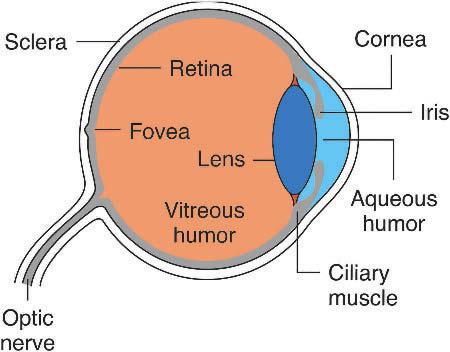
humor) directly behind the cornea (anterior chamber); the iris, which is the area of the eye that has color; and the black dot at the center of the eye that we call the pupil. Finally, a lens is located directly behind the iris, and a second area of fluid is found between the lens and the back surface of the eye (vitreous humor). The cornea and anterior chamber function much like a lens to focus the light on the back surface of the eye where the optical sensors are located (much like the film or sensor plate in a digital or video camera). The size of the pupil is controlled by a set of muscles in the iris that regulate the amount of light entering the eye. The more light that the eye is exposed to, the smaller the pupil becomes. The lens is controlled by a second set of muscles (ciliary muscles) that modify the shape and thickness of the eye, enabling it to focus on different objects and at different distances.
The second primary component group of the eye includes the retina, the interior wall at the back of the eye. This is the portion of the eye where optical sensors are located and where the eye attempts to focus its images. A special portion of the retina known as the fovea is located near the center of the retina. This area has a much higher concentration of photosensitive cells and is responsible for much of our ability to distinguish both colors and detail. A second area of the retina is the optic disk, which forms the location where the nerve endings of the photoreceptors are bundled together to form the optic nerve. The optic nerve carries nerve impulses to the brain where they are processed into images.
The third and final group of primary eye components includes the photoreceptors, specialized cells that convert light exposure to a neural impulse that is sent to the brain. A typical human eye contains approximately 128 million photoreceptors. There are two types of photoreceptors, each with a different function. The first, the rods, are sensitive to light across a wide range of wavelengths and luminous levels. The rods are predominantly responsible for our sight both at low levels of illumination and for distinguishing our peripheral vision, which is often referred to as scotopic vision. The second type of receptors, cones, are responsible for both our color and detail vision within light levels associated with typical interior and exterior illuminances. This type of vision is known as photopic vision. The fovea contains cones, while the remainder of the retina contains both cones and rods. Rods and scotopic vision are associated with night vision, and cones and photopic vision with day vision.
The structure of the eye and its various photoreceptors ultimately determine an individual’s sight. When the structure of the eye is abnormal, and the lens doesn’t focus the light properly on the retina, an individual can be either near- or farsighted and must wear corrective lenses. The structure of your eye may change throughout
Figure 2.1 Physiology of the eye
your lifetime as the lens slowly ages, becoming more rigid and less pliable. LASIK surgery reshapes the lens in order to refocus the light properly onto the retina. Some of us are light sensitive and find a bright sunny day to be a painful sensation while others have problems seeing objects in the dark. Color blindness is another condition in which the eyes don’t perform normally. The causes of these problems are often related to a physical impairment of the eye.
In addition to any problems with the eye itself, there are a number of psychological effects that can have an additional impact on your vision. Some of these can improve your sight, while others can create problems. More importantly, these effects usually relate to your perception of light and vision, not necessarily to the actual amount of light that your eyes sense. In any case, a lighting designer must be aware of these effects in order to create designs that will compensate for any of these issues. Later portions of this chapter discuss several of the most important issues related to light and perception.
ComPosition
Since light is the primary means by which we sense an environment, it is through its revelation of composition that we can comprehend a space. Without light, our perception of an environment is severely impaired. Whether you are lighting a stage, exhibit hall, or office, the entire environment is seen as a total composition. The architectural or scenic units, people and their clothing, as well as furniture and building materials are all elements that are revealed through the lighting. Light provides us with a means of indicating depth; it modifies the colors and textures of the other elements, reveals form, and indicates areas of focus or interest within the composition of a stage or room. Elements that are more important will usually be treated with higher light intensities, while the degree of overall visibility can be established by setting threshold levels that illuminate the environment as a whole. At any given time, there will always be a complete composition for an environment— and much of the way that it is revealed to us is through the basic task of illumination.
While many environments incorporate relatively constant lighting treatments, entertainment lighting generally makes use of ever-changing compositions and a very dynamic lighting style. Unlike a painting, which has a static composition, the stage is constantly evolving into new compositions. Where is the focus at this particular moment? How bright does the room absolutely have to be? Is there an area we wish to take an audience’s attention away from? Can a certain color be enhanced at a particular time? All of these questions relate to how the composition and lighting might change from one moment to another. The idea of creating dynamic
lighting was for many years limited to the entertainment field, but today’s architects and illuminating engineers also recognize the need for creating dynamic environments for their clients. Although it is generally subtle in comparison to theatrical venues, the lighting of buildings, trade shows, and exhibits can also employ active lighting elements for many projects.
VisibiLity
Visibility refers to allowing the viewers’ eyes and mind to be stimulated to such a degree that they can make an observation. Visibility, however, is a relative term, and we need to examine it in terms of specific contexts. In the most basic sense, it refers to the effect of providing enough visual information so that viewers can establish a meaning from what you have presented them with. In a way, visibility becomes a means of communication. If done well, the message is received—but if done poorly, the message becomes confused or is lost. Historically, there have been two basic approaches for creating visibility through light. The first is based on providing good uniform illumination over a widely dispersed area, where quantity of light is considered a major component of visibility. The second relates to the quality of the visual experience and refers to visibility in terms of what needs or doesn’t need to be seen by an observer—a concept that we refer to as quality of light. In other words, we increase visibility to a point where we reveal only enough of a subject to bring meaning to an audience and therefore become more selective in what we do or don’t reveal. Most lighting designers refer to this as selective visibility—revealing only what is necessary to bring meaning to a viewer. Directors of the 1940s and ’50s were frequently trained to believe that the audience had to see the actors’ faces in order to hear them, a concept that by today’s standards is severely limited. Today, shadows, distorted colors, and even low intensities have become common techniques for manipulating lighting to express mood and style associations, which can actually produce a more effective image than simply bringing visibility to an environment.
Illuminating engineers generally refer to the demand for successful vision or the ability to see accurately as visual acuity. This essentially refers to being able to manipulate the visual stimulus and environment in such a way that a given visual task can be completed. Visual acuity is actually a function of factors such as the size of the object, distance between the object and viewer, surface reflectivity of the object, and amount of illumination present, as well as sensitivity of the optic sensors. For example, small text has a more limiting effect on visual acuity than large text. A reading lamp, on the other hand, might be used to help raise the visual acuity of a page. A general rule has been to associate more critical tasks with the need for more illumination.
Hence, working in a classroom demands brighter conditions than eating in a restaurant, while performing surgery in a hospital operating room would require still higher levels of illumination. However, a number of consequences have also been associated with maintaining overly consistent levels of illumination within a given environment—especially when those levels are maintained at either relatively high or low intensity levels. A number of these effects are examined a bit later in this chapter.
intensity or brightness
While visibility may be modified through any one of the controllable qualities of light, we often associate the most important element of visibility with the control of intensity or brightness. For now, we’ll primarily examine the effects of intensity on vision. The other controllable qualities and their effects on vision will be addressed throughout later portions of this chapter. The eye is an amazing mechanism in that it can observe an incredible range of light intensities. While at one extreme we might observe light so bright that it could damage our eyes (such as in looking at the sun or a welder’s arc) we can also observe light in intensities as low as that of a candle flame or match strike from more than 10 to 15 miles away (once again using the example of the military scout plane to spot enemy troops at night). Additionally, we can perceive relatively small variations in intensity across our field of vision. This extreme range of sensitivity is characteristic of the human eye and cannot be found in equipment such as cameras or other optical sensors. A camera is usually not as sensitive to these variations and will recognize only the broader extremes of illumination levels within a given camera frame. When we work with cameras, we often refer to their contrast ratio, which refers to the range of intensities between the brightest and darkest elements of a camera’s view. The reason many of us shoot so many “bad” photographs is due most commonly to the limited sensitivity and contrast ratios of the film and/or cameras that we are using. Fortunately, technology continues to improve: cameras are ever more sensitive to light and offer a wider range of contrast ratios. The personal digital camera that I currently own (and quite possibly my smartphone camera) probably has better light sensitivity than many of the commercial cameras that were available just a few years ago.
Relative Intensity
In many cases, what is more important to a theatrical lighting designer is the perceived, rather than the actual or absolute, brightness of an object or light source. We have learned that simply adding more light to an environment doesn’t always produce better visibility. An object’s perceived brightness is a function of several items, not
just the amount of light focused onto it. Other factors include the distances between the source, object, and viewer; the reflectivity of the object; and the sensitivity of the optical device (eye or camera). In the early days of television and film lighting, cameras weren’t nearly as sensitive as they currently are, and directors of photography were much more concerned with creating minimum intensity thresholds so that the cameras could simply process the information necessary to create an image. The film speeds that you would select on a single-lens reflex film camera help you adjust the camera’s light sensitivity to a given film or digital sensor plate. If you set the ASA (American Standard Association) setting incorrectly you will end up with photographs that are either over or underexposed. Even though cameras are vastly improved, it is still quite common for designers working in the video and film industries to use a light meter to ensure that both even and minimal intensity levels are created for a shoot.
As a whole, we consider the brightness of a subject compared with that of both the surrounding environment and other objects—the relative intensities of these objects. What is important is that an object often receives focus if it is lit more brightly than the objects that surround it. On the other hand, our attention might also be drawn to the darkest part of a stage—like the upstage entrance tunnel of a cave in a production of Swiss Family Robinson. In both cases, the eye is attracted to the most different element of the scene, and the relative intensities of the objects play a more significant role in determining the focus than the actual intensities. We also refer to brightness perception when we consider all of the variables that result in determining the overall brightness of a particular subject. The amount of light falling on the object, our optical sensitivity, and the degree of reflectivity are all factors in determining the perceived intensity of an object.
Psychological Responses
Finally, there is the element of psychological response to the intensity of light. Most importantly, this plays a role in the determination of the mood of the occupants in a lit environment. As a whole, well-lighted environments produce an emotional response in the occupants that is positive and healthy. Poorly lit rooms and corridors can produce gloomy environments that tend to have a negative impact on the inhabitants’ moods. Studies have indicated an association between people’s mood and the hours of sunlight exposure that they receive in a typical day. A condition known as Seasonal Affective Disorder (SAD) is a form of depression that affects people during the winter who live in latitudes where they aren’t exposed to enough sunlight in a typical day. Elevated brightness has been associated with increases in an individual’s heart and respiration rates, while studies have
